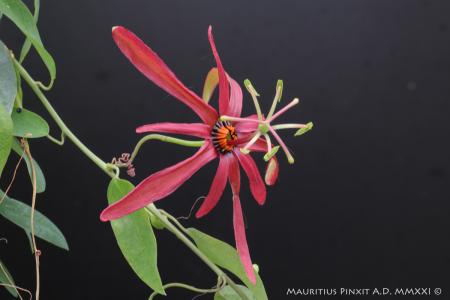
SUBGENUS: decaloba
SUPERSECTION: decaloba
SECTION: decaloba
GEOGRAPHICAL DISTRIBUTION OR ORIGIN:
Bahamas, eastern Cuba, Haiti.
MINIMUM TEMPERATURE: 12 °C
IDEAL MINIMUM TEMPERATURE: 15 °C
SYNONYMS: P. cephaleima Bory.
ETYMOLOGY: From the Latin cuprum, copper, referred to the copper colour of the petals and of the sepals.
DESCRIPTION:
This passionflower's corolla, with its maximum diameter of 8 cm, has a rare and singular colour. The petals and sepals look like they are made of thin, narrow, elongated sheets of copper. Some are folded back and occasionally twisted, meaning that the flower takes on an asymmetrical, dishevelled and wavy appearance. It is greatly appreciated for these characteristics.
The short and small corona of filaments, arranged in a cone around the long and thin androgynophore, is glossy and very dark red at the base but fades to an intense yellow-orange at the apex.
The filaments of the anthers and styles are also long and thin. Its fruits are just 1 cm in diameter and have a spherical shape.
P. cuprea has thin, serpentine stems with elongated internodes. It has small whole ellipsoidal leaves, which rarely reach 6 cm in length. They are supported by long, glandless petioles. The general appearance is that of a very light and sparse climber, of a glaucous green colour, where only the flowers stand out for their size and strong colours.
It is a lively, robust and adaptable plant. It rarely suffers from adversity, and always manages to grow and bloom with surprising abundance, even when not cared for. Its lack of hardiness is the only problem to be taken into account, given our climate. In winter, the ideal temperature to keep it healthy is quite high, around 15°C. It is, therefore, necessary to keep it in a greenhouse or in the home, as long as it is placed in a well-lit area, near a window.
It grows well in a pot with appropriate supports in wire mesh or built with bamboo canes at least one metre high. It prefers rich but well-drained soil, which must be allowed to dry out between watering.
In nature, P. cuprea is widespread across many Caribbean islands, from Cuba to the Bahamas; however, it is rare among collectors as it has only been cultivated for a few years.
It is propagated from cuttings, while it is more difficult to find its seeds.